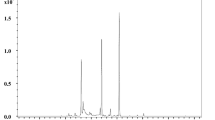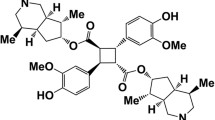Abstract
The aim of the presented study was to examine the potential antinociceptive, antiedematous (anti-inflammatory), and antiallodynic activities of two 1H-pyrrolo[3,4-c]pyridine-1,3(2H)-dione derivatives (DSZ 1 and DSZ 3) in various experimental models of pain. For this purpose, the hot plate test, the capsaicin test, the formalin test, the carrageenan model, and oxaliplatin-induced allodynia tests were performed. In the hot plate test, only DSZ 1 in the highest dose (20 mg/kg) was active but its effects appear to be due to sedatation rather than antinociceptiveness. In capsaicin-induced neurogenic pain model, both compounds displayed a significant antinociceptive activity. In the formalin test, DSZ 1 and DSZ 3 (5–20 mg/kg) revealed antinociceptive activity in both phases but it was more pronounced in the second phase of the test. In this test, pretreatment with caffeine, DPCPX reversed the antinociceptive effect of DSZ 3. On the other hand, pretreatment with L-NAME diminished the antinociceptive effect of DSZ 1. Pretreatment with naloxone did not affect antinociceptive activity of both compounds. Similar to ketoprofen, DSZ 1 and DSZ 3 showed antiedematous (antiinflammatory) and antihyperalgesic activity, and similar to lidocaine local anesthetic activity. Furthermore, both compounds (5 and 10 mg/kg) reduced tactile allodynia in acute and chronic phases of neuropathic pain. In the in vitro studies, DSZ 1 and DSZ 3 reduced the COX-2 level in LPS-activated RAW 264.7 cells, which suggests their anti-inflammatory activity. In conclusion, both DSZ 1 and DSZ 3 displayed broad spectrum of activity in several pain models, including neurogenic, tonic, inflammatory, and chemotherapy-induced peripheral neuropathic pain.













Similar content being viewed by others
References
Bonet IJ, Fischer CA, Parada CH, Tambeli (2013) The role of transient receptor potencial A1 (TRPA1) in the development and maintenance in carrageenan induced hyperalgesia. Neuropharmacology 65:206–212
Chłoń-Rzepa G, Ślusarczyk M, Jankowska A, Gawalska A, Bucki A, Kołaczkowski A, Świerczek A, Pociecha K, Wyska E, Zygmunt M, Kazek G, Sałat K, Pawłowski M (2018) Novel amide derivatives of 1,3-dimethyl-2,6-dioxopurin-7-yl-alkylcarboxylic acids as multifunctional TRPA1 antagonists and PDE4/7 inhibitors: a new approach for the treatment of pain. Eur J Med Chem 5:517–533
Cury Y, Picolo G, Gutierrez VP, Ferreira SH (2010) Pain and analgesia: the dual effect of nitric oxide in the nociceptive system. Nitric Oxide 25:243–254
Dziubina A, Szmyd K, Zygmunt M, Sapa J, Dudek M, Filipek B, Drabczyńska A, Załuski M, Pytka K, Kieć-Kononowicz K (2016) Evaluation of antidepressant- and anxiolytic-like activity of purinedione – derivatives with affinity to A2A receptors in mice. Pharmacol Res 68:1285–1292
Eddy N, Leimbach D (1953) Synthetic analgesics. II Dithienylbutenyl - and dithienylbutylamines J Pharmacol Exp Ther 107:385–393
Erenmemisoglu A, Suer C, Temocin MH (1994) As nicotine a local anaesthetic action ? J Bas Clin Physiol Pharmacol 5:125–131
Fattori V, Hohmann SN, Rossaneis AC, Pinho-Ribeiro FA, Verri WA (2016) Capsaicin: current understanding of its mechanisms and therapy of pain and other pre-clinical and clinical uses. Molecules 21(7):844
Fereira SH, Duarte IDG, Lorenzetti BB (1991) The molecular mechanism of action of peripheral morphine analgesia: stimulation of the cGMP system via nitric oxide release. Eur J Pharm 201:121–122
Flatters SJL, Dougherty PM, Colvin LA (2017) Clinical and preclinical perspectives on chemotherapy-induced peripheral neuropathy (CIPN): a narrative review. Br J Anaesth 119(4):737–749
Florentino I, Galdino PM, De Oliveira LP, Silva DP, Pazini F et al (2015) Involvement of the NO/cGMP/KATP pathway in the antinociceptive effect of the new pyrazole 5-(1-(3-fluorophenyl)-1H-pyrazol-4-yl)-2H-tetrazole (LQFM-021). Nitric Oxide 47:17–24
Gao X, LuQ CG, Wang Z, Pan R, Xia Y, Hu H, Dai Y (2014) Norisoboldine attenuates inflammatory pain via the adenosine A1 receptor. E J Pain 18:939–948
Giorno TBS, Ballard YLL, Cordeiro MS, Silva BV, Pinto AC, Fernands PD (2015) Central and peripheral activity of 3-(2-oxopropyl)-3-hydroxy-2-oxindoles. Pharmacol Biochem Behav 135:13–19
Gdula-Argasińska J, Bystrowska B (2016) Docosahexaenoic acid attenuates in endocannabinoid synthesis in RAW 264.7 macrophages activated with benzo(a)pyrene and lipopolysaccharide. Toxicol Lett 258:93–100
Homayounfar H, Jamali-Raeufy N, Sahebgharani M, Zarrindast M-R (2005) Adenosine receptor mediates nicotine - induced antinociception in formalin test. Pharmacol Res 51:197–203
Hong Y, Abbott FV (1995) Peripheral opioid modulation of pain and inflammation in the formalin test. Eur J Pharmacol 277:21–28
Hunskaar S, Fasmer O, Hole K (1985) Formalin test in mice, a useful technique for evaluating mild analgesics. J Neurosci Methods 14:69–76
Lázaro-Ibáñez GG, Torres-López JE, Granados-Soto V (2001) Participation of the nitric oxide-cyclic GMP-ATP-sensitive K+ channel pathway in the antinociceptive action of ketorolac. Eur J Pharmacol 426:39–44
Lencˇe P (1962) A new device for plethysmoscopic measuring of small objects. Arch Int Pharmacodyn Ther 136:237–240
Litchfield JT, Wilcoxon E (1949) A simplified method of evaluating dose-effect experiments. J Pharmacol Exp Ther 96:99–113
Lozana-Cuenca J, Castaneda- Hernandez G, Granado –Soto (2005) Peripheral and spinal mechanizms of antinociceptive action of lumiracoxib. Eur J Pharmacol 513:81–91
McNamara CR, Mandel-Brehm J, Bautista DM (2007) TRPA1 agonist mediates formalin-induced pain. PNAS 104:13525–13530
Moalem G, Tracey DJ (2006) Immune and inflammatory mechanisms in neuropathic pain. Brain Res Rev 51:240–264
Munro G (2009) Pharmacological assessment of the rat formalin test utilizing the clinically used analgesic drugs gabapentin, lamotrigine, morphine, duloxetine, tramadol and ibuprofen: influence of low and high formalin concentrations. Eur J Pharmacol 605:95–102
Randall LO, Selitto JJ (1957) A method for measurement of analgesic activity of inflamed tissue. Arch Int Pharmacodyn 111:409–419
Salvemini D, Little JW, Doyle T, Neumann WL (2011) Roles of reactive oxygen and nitrogen species in pain. Free Radic Biol Med 51:951–966
Sałat K, Librowski T, Filipek B (2010) Pharmacological profile of three different γ-butyrolactone derivatives in mice. JPCCR 4:014–018
Sałat K, Cios A, Wyska E, Sałat R, Mogilski S et al (2014) Antiallodynic and antihyperalgesic activity of 3-[4-(3-trifluoromethyl-phenyl)-piperazin-1-yl]-dihydrofuran-2-one compared to pregabalin in chemotherapy-induced neuropathic pain in mice. Pharmacol Biochem Behav 122:173–181
Sałat K, Filipek B (2015) Antinociceptive activity of transient receptor potential channel TRPV1, TRPA1, and TRPM8 antagonists in neurogenic and nuropatic pain models in mice. Biomed &Biotechnol 16:167–178
Sałat K, Furgała A, Sałat R (2019) Interventional and preventive effects of aripiprazole and ceftriaxone used alone or in combination on oxaliplatin-induced tactile and cold allodynia in mice. Biomed & Biotechnol 111:882–890
Sawynok J (2016) Adenosine receptor targets for pain. Neurosci 338:1–18
Sawynok J, Reid AR (2012) Caffeine ihibits antinociception by acetaminophen in the formalin test by inhibiting spinal adenosine A1 receptor. Eur J Pharmacol 674:248–254
Sawynok J, Reid AR, Fredholm B (2010) Caffeine reverses antinociception by oxcarbazepine by inhibition of adenosine A1 receptors: insights using knockout mice. Neurosci Lett 473:178–181
Sawynok J, Reid AR, Fredholm B (2008) Caffeine reverses antinociception by amitriptyline in wild type mice but not in those lacking adenosine A1 receptors. Neurosci Lett 440:181–184
Da Settimo A, Primofiore GF, Da Settimo F, Simorini C, La Motta A, Martinell P, Boldrini E (1996) Synthesis of pyrrolo[3,4-c]pyridine derivatives possessing an acid group and their in vitro and in vivo evaluation as aldose reductase inhibitors. Eur J Med Chem 31:49–58
Śladowska H, Filipek B, Szkatuła D, Sabiniarz A, Kardasz M, Potoczek J et al (2002) Investigations on the synthesis and pharmacological properties of 4alkoxy-2-[2-hydroxy-3-(4-aryl-1-piperazinyl)propyl]-6-methyl-1Hpyrrolo[3,4-c]pyridine-1,3(2H)-diones. Farmaco 57:897–908
Śladowska H, Filipek B, Szkatuła D, Sapa J, Bednarski M, Ciołkowska M (2005) Investigations on the synthesis and pharmacological properties of N-substituted derivatives of 4-alkoxy-6-methyl-1H-pyrrolo[3,4-c]pyridine-1,3(2H)-diones. Farmaco 60:53–59
Śladowska H, Sabiniarz A, Szkatuła D, Filipek B, Sapa J (2006) Synthesis and properties of 4-alkoxy-2-[2-hydroxy-3-(4-o,m,phalogenoaryl-1-piperazinyl)propyl]-6-methyl-1h-pyrrolo[3,4-c]pyridine-1,3(2h)-diones with analgesic and sedative activities. Acta Pol Pharmac-Drug Res 63:245–254
Śladowska H, Szkatuła D, Filipek B, Maciąg D, Sapa J, Zygmunt M (2001) Synthesis and properties of 2-(4-substituted)butyl derivatives of some 2,3-dihydro-1,3-dioxo-1H-pyrrolo[3,4-c] pyridines. Pharmacie 56:133–138
Tsatsanis C, Androulidiaki A, Venihaki M, Mariqionis AN (2006) Signalling networks regulating cyclooxygenase-2. Int J Biochem Cell Biol 38:1654–1661
Willis WD (2009) The role of TRPV1 receptors in pain evoked by noxious thermal and chemical stimuli. Exp Brain Res 196:5–11
Winter CA, Risley EA, Nuss GW (1962) Carrageenin - induced edema in the hind paw of the rat as an assay for anti-inflammatory drugs. Proc Soc Exp Biol Med 111:544–547
Wójcicka A, Becan L, Junka A, Bartoszewicz M, Secewicz A, Trynda J, Wietrzyk J (2017) Synthesis and biological activity of novel 6-phenyl-1h-pyrrolo[3,4-c]pyridine-1,3-dione derivatives. Acta Pol Pharmac- Drug Res 74:435–443
Funding
The study was financially supported by Jagiellonian University Collegium Medicum statutory grant: K/ZDS/006237 and N42/DBS/000049.
Author information
Authors and Affiliations
Contributions
AD was responsible for the study concept, design, acquisition, and analysis of animal data, conducted the in vivo experiment, and drafted the manuscript.
DS was responsible for the generation, synthesis of the novel compounds, and critical revision for manuscript.
G-A J was responsible for in vitro experiment in cell line.
MK was responsible for determination of antioxidant activity.
BF provided critical revision for the manuscript.
All authors critically reviewed content and approved final version for publication.
Corresponding author
Ethics declarations
All applicable international, national, and/or institutional guidelines for the care and use of animals were followed. All experimental procedures were conducted in accordance with the European Union Directive of 22 September 2010 (2010/63/EU) and Polish legislation concerning animal experimentation. The study was carried out under experimental protocols approved by the Local Ethical Committee in Kraków, Poland (Approval No. 4/2016, 180/2017, 181/2017, 151/2018, 218/2019).
Conflict of interest
The authors declare that they have no conflicts of interests.
Additional information
Publisher’s note
Springer Nature remains neutral with regard to jurisdictional claims in published maps and institutional affiliations.
Rights and permissions
About this article
Cite this article
Dziubina, A., Szkatuła, D., Gdula-Argasińska, J. et al. Antinociceptive, antiedematous, and antiallodynic activity of 1H-pyrrolo[3,4-c]pyridine-1,3(2H)-dione derivatives in experimental models of pain. Naunyn-Schmiedeberg's Arch Pharmacol 393, 813–827 (2020). https://doi.org/10.1007/s00210-019-01783-3
Received:
Accepted:
Published:
Issue Date:
DOI: https://doi.org/10.1007/s00210-019-01783-3




